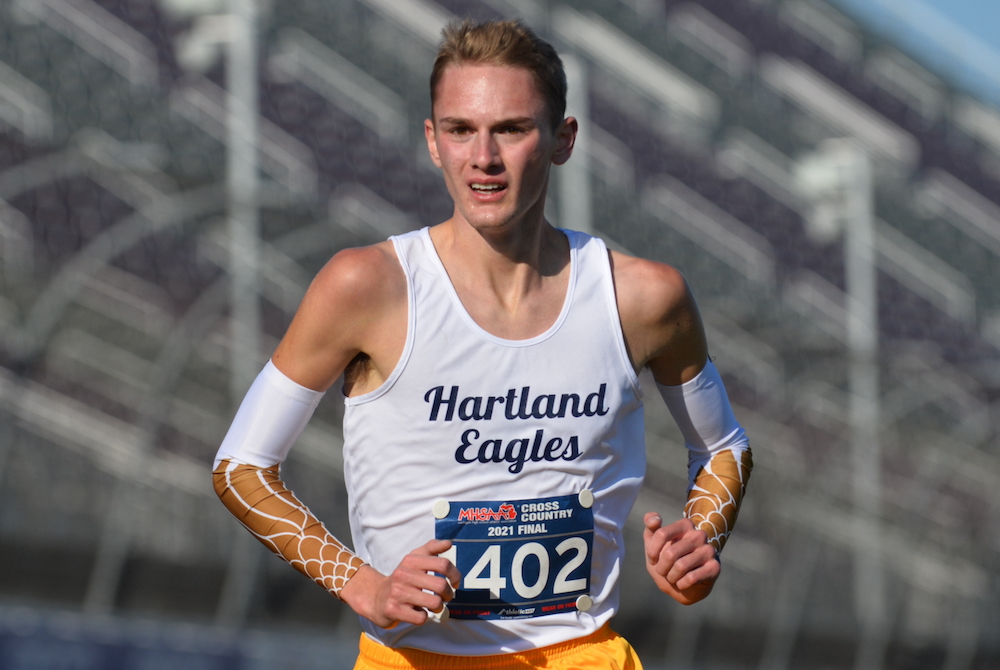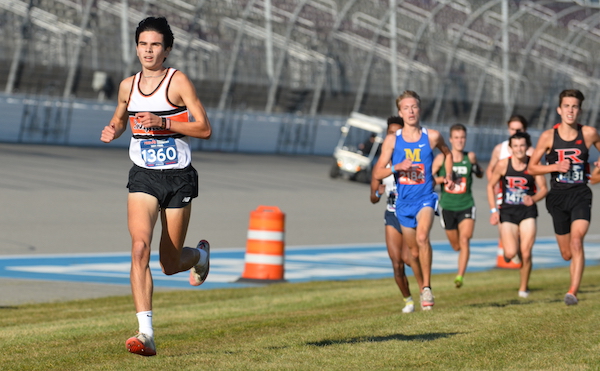
Hartland Ace Makes More History, Brighton Back to Front of Pack
November 6, 2021
BROOKLYN — Riley Hough of Hartland is flattered whenever his name is mentioned in the same breath as Dathan Ritzenhein’s.
Few runners who have come along in the last 21 years inspired any comparisons to the former Rockford great, whose time of 14:10.4 in the 2000 MHSAA Lower Peninsula Division 1 meet is the fastest high school performance in history.
After breaking Ritzenhein’s course record at the Portage Invitational with a time of 14:37.1 on Oct. 9, Hough did something the three-time Olympian never accomplished at MIS by breaking 15 minutes for the second time.
Hough’s time of 14:56.47 Saturday at MIS came one year after he won in 14:49.62, a time that’s second only to Ritzenhein’s record.
Six other runners have gone under 15 minutes at MIS, but none more than once. Ritzenhein came the closest before Hough, winning the 1999 Class A meet in 15:05.4 before his awe-inspiring effort as a senior.
As far as Hough is concerned, he wants to leave his own legacy apart from anyone who came before him.
“Obviously, I have some of his records in some of the other invitationals,” Hough said. “Honestly, I feel I’m just making a name for myself instead of just trying to replace someone else.”
Hough finished the season 13-0, winning his last 24 races in a Hartland uniform.
 Farmington’s Peter Baracco, like Hough a four-time all-stater, was less than a second off the pace at the mile mark, which Hough reached in 4:50.9. With a 4:44.3 second mile, Hough obliterated the field by opening up a 27.5-second lead.
Farmington’s Peter Baracco, like Hough a four-time all-stater, was less than a second off the pace at the mile mark, which Hough reached in 4:50.9. With a 4:44.3 second mile, Hough obliterated the field by opening up a 27.5-second lead.
Hough’s possible successor, Grand Haven sophomore Seth Norder, moved from 10th place at the two-mile mark to second by the end of the race. Norder crossed the line in 15:25.69.
Winning the team championship for the second time in three years was Brighton, which outscored runner-up Caledonia, 141-175.
The Bulldogs have five different scoring runners from their 2019 team, with only one runner back from the seven who took the course two years ago.
Senior Quinn Cullen ran a personal-best 15:37.54 to lead Brighton, placing sixth individually.
Senior Jack Campbell was 32nd in 16:06.54, senior Lucas Seng was 36th in 16:10.69, sophomore Tyler Langley was 45th in 16:16.84 and junior Dylan White was 97th in 16:42.70.
“It’s just a testament to the amount of work these kids put into it,” Brighton coach Chris Elsey said. “We’ve got a great core group of kids. Seven ran here today, but we’ve got 20, 25 guys who are part of that core group who work hard through the winter, work hard through the summer, in the spring in track. It’s hard to put into words.”
PHOTOS (Top) Hartland’s Riley Hough closes in on a repeat Division 1 championship Saturday. (Middle) Brighton’s Quinn Cullen leads a pack toward the finish while setting the pace for the eventual team title winner. (Click for more from RunMichigan.com.)

MHSAA Vault: MIS Rose to Challenges to Host 2020 LP Finals
By
Rob Kaminski
MHSAA benchmarks editor
November 12, 2021
The “MHSAA Vault” features stories from past publications and other documents in the MHSAA Library. This issue takes a look at the MHSAA Cross Country Finals at Michigan International Speedway, which celebrated 25 years in 2020 – although it was an event that nearly didn’t happen last fall …
In 1996, the MHSAA and Michigan International Speedway began a partnership the changed the course of the Lower Peninsula Cross Country Finals – quite literally.
The land in and around the track at Brooklyn would host the Finals for all classes of runners in one place on one day, an annual festival of nearly 2,000 runners competing for the MHSAA’s top honors.
Even skeptics – and there were several among running purists who thought the course was too flat, for example – can’t deny the results.
Finals attendance nearly doubled in that first year, and crowds in excess of 10,000 have enjoyed a day of racing several times, including a record 12,153 in 2011.
Enthusiastic crowds were the norm in recent years, with 11,232 in 2017, and nearly 11,000 in 2018 (10,989) and 2019 (10,873).
In fact, attendance failed to reach at least 8,000 only twice since the move to MIS.
Of course, last year was an exception, when attendance was limited to 1,000 spectators per session due to the COVID-19 Pandemic. Fans also were restricted to the grandstands rather than following the action throughout locations on the course.
To reduce the number of runners in each race, the event was spread over two days, with each Division being run in two separate “sections” with times then combined at the end to determine team and individual champions.
While not ideal, the end result was another year of fantastic efforts at MIS – both from student-athletes and those behind the scenes.
“Even at the last hour, less than a week ahead of the Finals, we were closer to not having the Finals than we were to having them,” said MHSAA Assistant Director Cody Inglis, who coordinates the cross country postseason. “Rumors and challenges of mandated shutdowns, testing and other requirements were being discussed and caused a lot of unknowns. Even at the Regional level, we had schools, Regional courses and hosts shutting down their facilities; we had to relocate four Regionals 48 hours prior to race times. That scenario just could not happen at the Finals level where far more runners and much more travel would be involved.”
Among the many last-minute hurdles was the edict from NASCAR – which owns MIS – that all persons on site be temperature checked upon entry. That meant securing thermometers that were easy to operate in short order, along with personnel necessary to conduct the readings.
The attendance limitations certainly helped to implement the temperature screening, but brought their own issues.
“Limiting spectators was not a popular decision, but it really was the only way to have a race,” Inglis said. “We were taking direction and working with policies and protocols from the MDHHS, the Governor’s office, Lenawee County Health Department, MIS and NASCAR.”
Part of the solution was to utilize the grandstands as a “barrier” between participants and spectators. The reduced number of fans were dispersed over thousands of seats while still allowing them the chance to watch their student-athletes compete.
“It wasn’t the same, it wasn’t easy or perfect, but it was what we had to do to have a race,” Inglis said. “Separating the Finals into two days and different sections also allowed us to spread out the event and limit the number of people on site at any one time. This was a key part of the plan and worked well even though it separated races within a Division.”
The MHSAA, MIS and the cross country community never lost focus of the main goal: a culmination of the season for the student-athletes, who deserved something last year more than ever. And, more than ever, MIS once again displayed its advantage as a venue that could adapt to the fluid nature of the times to pull off the event.
“There were some thoughts of using four different sites, but as we learned during the Regionals, the climate of things was so tenuous from one area of the state to another that we couldn’t be 100-percent certain that there wouldn’t again be last-minute cancelations,” Inglis said. “MIS was wonderful to work and collaborate with, and was the best option to get it done. It was never mentioned once publicly about the possibility of not having the Finals – only how we could best do it under uncharted conditions.”
The moving parts and ever-changing scenarios created more complexity than ever in finalizing a season, but every decision was made with the complete desire to conduct the Finals as close to normal as possible.
“I firmly believe that a finish to the season, no matter the differences in race formatting and fan experience, was something everyone would have taken when the season began in August,” Inglis said.
Indeed, the finish line in Year 25 at MIS might have been the most gratifying of them all.

